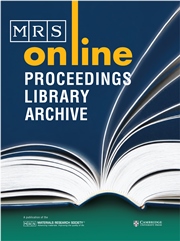Article contents
Determining Stress-strain Curves for Thin Films by Experimental/Computational Nanoindentation
Published online by Cambridge University Press: 01 February 2011
Abstract
The nanoindentation technique has great promise in evaluating mechanical properties such as nanohardness and elastic modulus at micrometer or nanometer scales, since sample preparation and testing procedures are very easy. However, the nanohardness and elastic modulus cannot be directly related to basic material flow properties. Here a novel and simple experimental/computational method is proposed to extract stress-strain curves based on finite-element modeling (FEM) of nanoindentation. This method was verified for bulk Al by comparing the stress-strain curves extracted with those obtained from tensile testing, and was applied to Al thin films (0.5 μm and 1 μm) deposited on a Si substrate.
- Type
- Research Article
- Information
- Copyright
- Copyright © Materials Research Society 2004
References
REFERENCES
- 3
- Cited by




